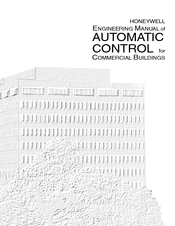User Manuals: Honeywell AUTOMATIC CONTROL Controllers
Manuals and User Guides for Honeywell AUTOMATIC CONTROL Controllers. We have 1 Honeywell AUTOMATIC CONTROL Controllers manual available for free PDF download: Engineering Manual
Honeywell AUTOMATIC CONTROL Engineering Manual (518 pages)
for COMMERCIAL BUILDINGS
Brand: Honeywell
|
Category: Controller
|
Size: 8 MB
Table of Contents
-
-
Definitions15
-
Introduction15
-
-
General18
-
General19
-
Heating19
-
Cooling21
-
General21
-
Ventilation23
-
Filtration24
-
-
-
Control Loop25
-
General26
-
General27
-
Step Control29
-
General31
-
Load36
-
General37
-
Lag37
-
Capacitance38
-
Dead Time39
-
Resistance39
-
-
-
Introduction48
-
Definitions48
-
-
-
-
Definitions69
-
Introduction69
-
Symbols71
-
Thermostats79
-
Controllers80
-
-
-
Ratio Relay91
-
-
-
Introduction
107 -
-
Application110
-
Actuators110
-
Controllers110
-
Equipment110
-
Relays110
-
Operation111
-
-
-
-
-
Application112
-
Controllers112
-
Equipment112
-
Operation112
-
-
-
-
-
Application116
-
Equipment116
-
Actuators116
-
Controllers116
-
-
Operation116
-
-
-
Application117
-
Equipment117
-
Actuators117
-
Controllers117
-
-
Operation118
-
General118
-
-
Unison Control123
-
-
-
Step Controllers124
-
Application124
-
Equipment124
-
Starters124
-
Operation125
-
-
-
-
Introduction
143 -
Definitions
143 -
Advantages
144 -
Background
144 -
-
-
Optimum Start148
-
Optimum Stop148
-
Enthalpy149
-
Load Reset149
-
Night Cycle149
-
Night Purge149
-
Zero Energy Band151
-
-
General152
-
-
Definitions
161 -
Introduction
161 -
Abbreviations
163 -
-
Air Contaminants164
-
General165
-
-
General173
-
-
-
-
General174
-
Graphic Displays178
-
Bibliography180
-
-
-
Definitions
182 -
Introduction
182 -
-
General183
-
Layout of System184
-
-
Objectives
183 -
-
-
Buoyancy185
-
Stack Effect185
-
Expansion186
-
Wind Velocity186
-
Hvac187
-
-
Control of Smoke187
-
Pressurization187
-
-
-
-
Bibliography
192
-
-
-
Definitions193
-
Introduction193
-
Definitions194
-
Introduction194
-
Background195
-
Introduction
195 -
Definitions
195 -
Background
196 -
-
System Functions199
-
Fiber Optic199
-
Phone Lines199
-
System Functions
200-
General200
-
-
Hardware200
-
Software200
-
Alarm Processing201
-
Reports201
-
Security201
-
Server201
-
System Graphics202
-
System Text202
-
-
Operation203
-
Control Graphics206
-
Data Penetration206
-
-
General207
-
-
-
-
-
Abbreviations
213 -
Introduction
213 -
-
Symbols218
-
-
-
-
Multizone Unit260
-
-
-
Introduction
275 -
Definitions
275 -
-
Ventilation279
-
Pressurization280
-
-
Fan Types282
-
General282
-
Fan Horsepower283
-
Fan Laws283
-
-
-
-
General291
-
Smoke Control296
-
Warm-Up Control296
-
-
-
Fume Hoods298
-
Types298
-
-
-
References
302
-
-
-
Introduction
307 -
Abbreviations
307 -
Definitions
307 -
Symbols
308 -
-
Introduction309
-
-
Absorption Cycle311
-
-
-
Control Modes327
-
General327
-
-
-
-
-
Introduction339
-
Boiler Types339
-
-
Gas Burners341
-
Oil Burners341
-
Boiler Controls342
-
-
General344
-
Modular Boilers347
-
-
-
-
Introduction347
-
-
Pump Performance349
-
Pump Efficiency350
-
System Curves352
-
Multiple Pumps355
-
Operation356
-
Dual Pump Curves357
-
-
-
-
General370
-
General371
-
General372
-
Hot Water Reset373
-
Three-Way Valve376
-
-
-
-
Introduction386
-
-
Actuators388
-
Valve Location388
-
Valve Packing388
-
Valve Size388
-
Valve Style388
-
Valve Trim388
-
-
HTW Coils390
-
-
-
Introduction392
-
Heat Sources392
-
The Substation393
-
-
Abbreviations393
-
Definitions394
-
Symbols394
-
-
Heat Generation395
-
Key Points396
-
Mixing Station396
-
-
-
Introduction
411-
Graphic Symbols412
-
Abbreviations413
-
-
Parallel Fan ATU418
-
Series Fan ATU418
-
Dual-Duct ATU420
-
-
-
General422
-
Radiant Panels423
-
Unit Heaters423
-
Unit Ventilators425
-
General425
-
Control426
-
Blocked Airflow432
-
Coil Freeze-Up432
-
Power Failure432
-
-
Fan Coil Units432
-
Heat Pumps435
-
General435
-
Operation435
-
Control Loops436
-
-
-
-
-
Definitions
442-
Valve Components442
-
Valve Flow Terms443
-
Valve Ratings443
-
Valve Types444
-
-
Introduction
442 -
Valve Selection
446-
Globe Valve447
-
Ball Valve447
-
Butterfly Valve447
-
Two-Way Valve448
-
Linear Valve449
-
Three-Way Valves450
-
Mixing Valve450
-
Diverting Valve451
-
-
-
Valve Sizing
451
-
-
-
Definitions
463 -
Introduction
463 -
Damper Selection
464-
Damper Types464
-
Round Dampers464
-
Fire Dampers466
-
Smoke Dampers466
-
Baffles467
-
Performance Data468
-
Leakage Ratings468
-
-
-
Velocity470
-
Corrosion471
-
Static Pressure471
-
Temperature471
-
Turbulence471
-
-
-
Damper Sizing
473
-
-
-
Weather Data
482-
Degree Days482
-
Heating Data483
-
Cooling Data484
-
-
Introduction
482 -
-
General485
-
Metric Prefixes485
-
Pressure485
-
Weight/Mass486
-
Area486
-
Length486
-
Volume487
-
Specific Heat487
-
Temperature487
-
Heat Transfer489
-
Flow489
-
Velocity489
-
Power490
-
Work/Energy490
-
Enthalpy491
-
Force491
-
Torque491
-
Density491
-
-
Electrical Data
492 -
Airflow Data
499-
Fan Ratings499
-
-
Advertisement
